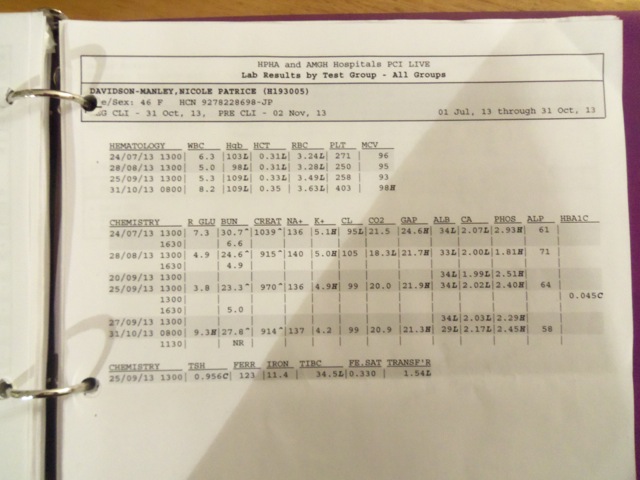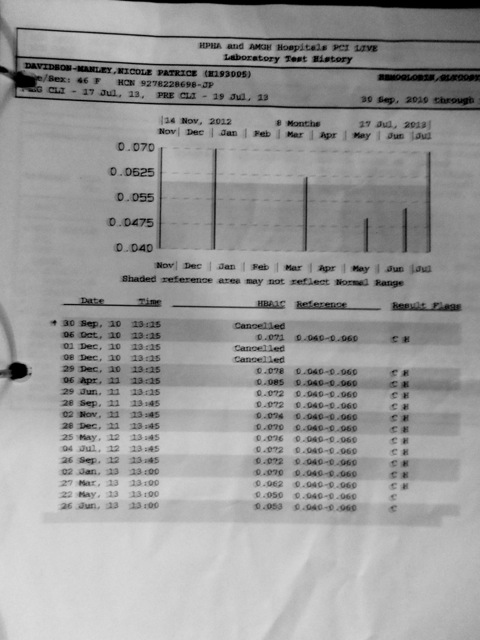As of January 2, 2013, my wife Nicole’s glycated hemoglobin (HgbA1C) test result was 7.0%.
Eight months later, September 25, 2013, her HgbA1C has dropped to 4.5%. A 2.5% reduction. You can view the lab results below (column on far right):

Following the dietary guidelines and insulin regimen in Dr. Bernstein’s Diabetes Solutions Nicole has already hit this lofty target in less than a year. By the fifth month (May 22, 2013) Nicole had already achieved a HgbA1C of 5.0%:
Even based on the questionable standards of the Canadian Diabetes Associate (CDA) Nicole’s previous HgbA1C of 7.0 was too high for most diabetics. The CDA generally aims for an HgbA1C of 6.0. Nicole had never been able to reach even this mediocre goal following the CDA’s high-carbohydrate dietary guidelines. But by eating a minimal amount of carbohydrates Nicole now has better HgbA1C than many (if not most) non-diabetics.
Isn’t a 4.5% HgbA1C Dangerously Low?
Oddly enough, the CDA actually recommends an HgbA1C of 8.0-8.5% for a “frail” adult diabetic. I assume this is because they want the patient to avoid hypoglycemia. This makes sense if one is consuming a high-carbohydrate diet. It would be very dangerous to aim for a 4.5% HgbA1C. The insulin injections would be too large.
Since adopting Dr. Bernstein’s low-carb program Nicole rarely has a severe hypoglycemic reaction. And when she does go low, she doesn’t suffer the disorientation and confusion she used to. She once hit 1.7 mmol/L (30.6 mg/dL) and was still able to do arithmetic, walk and yell at me. She barely even notices if she temporarily drops to 3.0 mmol/L (54 mg/dL). The low-carb diet seems to make the body so much better adapted to dealing with a hypoglycemic situation. I’ll write more about this in the future.
Isn’t a 6.0% HgbA1C Dangerously High?
A Japanese study concluded that a higher HgbA1c increased risk of death.
A study from the Netherlands showed that a higher HgbA1C (even in the non-diabetic range) increased risk of death from cardiovascular disease.
A paper from Ireland states “that HbA1c even in the range of 5.5% to 6.5% poses considerably high risk of morbidity and mortality.” It goes onto say that every 1% increase in HgbA1C can lead to a 15-18% risk increase of suffering cardiovascular disease.
A 2013 study in the Journal of the American Academy of Neurology showed that a lower HgbA1C preserves our memory and ability to learn as we get older.
A study in The New England Journal of Medicine showed that diabetics with a higher HgbA1C were more likely to develop dementia than those with a lower HgbA1C. A mere 1.4 mmol/L (25 mg/dL) increase in average blood sugar resulted in a 40% increase in dementia.
5.0 mmol/L (90 mg/dL) Average Blood Sugar
As far as the blood sugar management portion of our low-carb GAPS experiment goes, it’s proving a success. Her glucometer reports that her average blood sugar for the last seven days has been 5.0 mmol/L (90 mg/dL). That’s only 0.3 mmol/L higher than my average (non-diabetic) blood sugar. Clearly, the 4.5% HgbA1C does reflect a near normal blood sugar, in her case.
Of course, the HgbA1C test doesn’t reflect short rises in blood sugar which can still be damaging to the nerves, tissues and organs. Nonetheless, considering Nicole struggles with gastroparesis, chronic kidney failure and tachycardia, dropping her HgbA1C by 2.5% is a monumental achievement. It’s a testimony to both Dr. Bernstein’s Diabetes Solution and her own determination to overcome her diabetic challenges.

